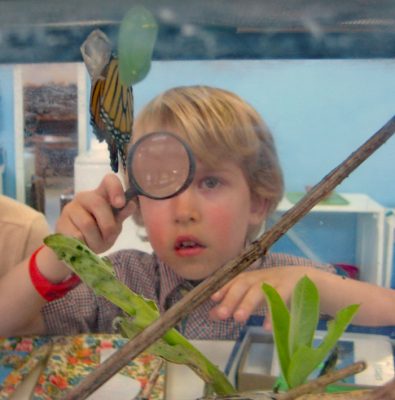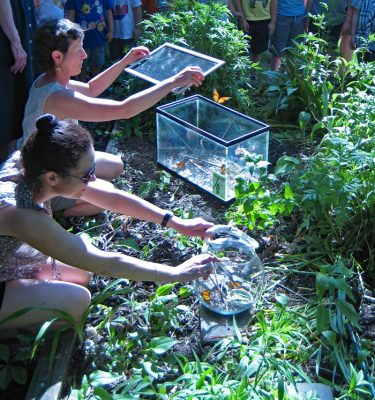By Marypat Ehlmann
Member-at-Large and Volunteer Coordinator, Wild Ones – St. Louis Chapter
In early/mid-April the St. Louis region received our first wave of monarchs migrating north. This was unexpected and about 4-6 weeks before most milkweed in neighborhood yards was tall enough to support feeding a brood of very hungry caterpillars.
As usual the female monarch butterflies laid eggs on as many various native milkweed varieties as they could find (some small plants in ground and some fuller plants in garden centers).
On April 14, at A Growing Place Montessori School, my classroom gained two milkweed plants both with eggs aboard. Then as a plea was heard to help with the monarch baby boom, our classroom adopted 15 of the tiny striped larvae, now totaling 19 caterpillars, to feed, clean up after, and eagerly observe.
Just as described in How to Raise Monarch Butterflies: A Step-by-Step Guide for Kids by Carol Pasternak, for the next two weeks larva ate milkweed leaves, pooped (called frass), rested, outgrew one skin for a larger size, and then ate some more. Thanks to several friends and neighbors, milkweed leaves were harvested, served fresh, and quickly eaten by the brood. Did I mention in this hectic time, three more caterpillars hatched?
At last, one by one, each big and bright caterpillar crawled to the screen lid on the glass case, wove it’s silk webbing to the screen, and hung head down in a J-shape. Then as if unzipping its striped caterpillar suit, the foam green chrysalis with golden spots transformed in front of us. Each day a new activity began as the children counted how many chrysalises were hanging and how many caterpillars remained. Soon all was quiet as our cages only held beautiful chrysalises.
Now we had another two-week waiting game. The first chrysalis formed on May 2 with our first butterfly having emerged (or eclosed) from that chrysalis on May 15 at 10:38 a.m. … it was a female. The children at A Growing Place witnessed the splendor of metamorphosis taking place before them, which allowed them to experience being citizen scientists in the process.
A total of 19 butterflies have been observed and, as in Mr. McGinty’s Monarchs by Linda Vander Heyden, each released in our school native garden. Truly, this has been a growing place and learning time for all of us!
[Not a valid template]



How wonderful for the kids and the Monarch population. A new generation of both children and Monarchs to appreciate Mother Nature and Science. Warms my heart. A big thanks to Marypat and all who helped
Thank you Marypat! Your descriptions really bring the experience alive. The students are lucky to witness the incredible transformation of the caterpillar into the beautiful and amazing monarch butterfly.
How wonderful for the children…and the monarchs!
Nice photos! Thanks for the journey.
Marypat,what a delightful chronicle of the journey of the monarchs; thank you for sharing!
This year at our school a primary parent planted milkweed seeds with each child so that more homes would have them available, Your post confirmed the importance of nurturing the milkweed so that we can nurture the monarchs.
As always, thanks for bringing the simple acts of kindness we can do that affect us all.
You rock, Teacher!
Wish I had you when I was in school
Awesome